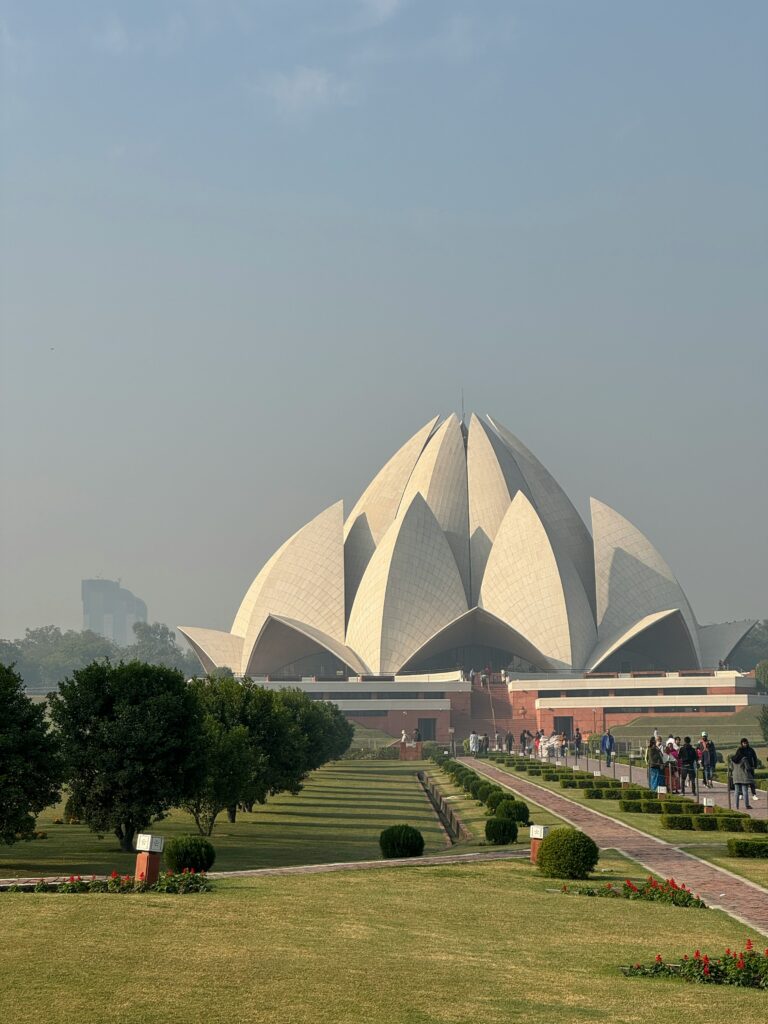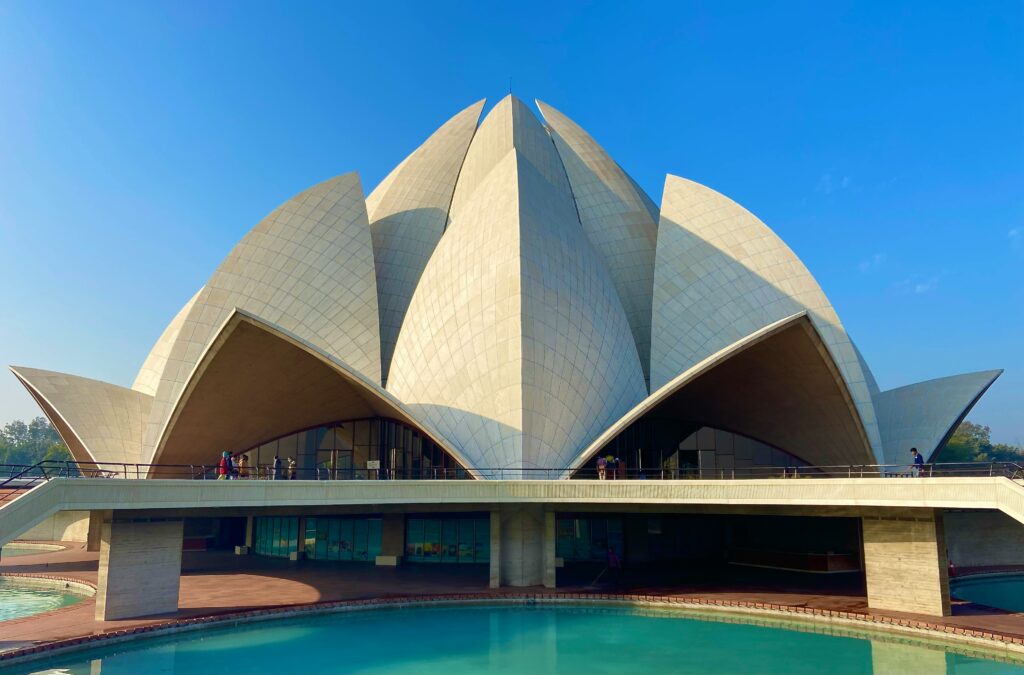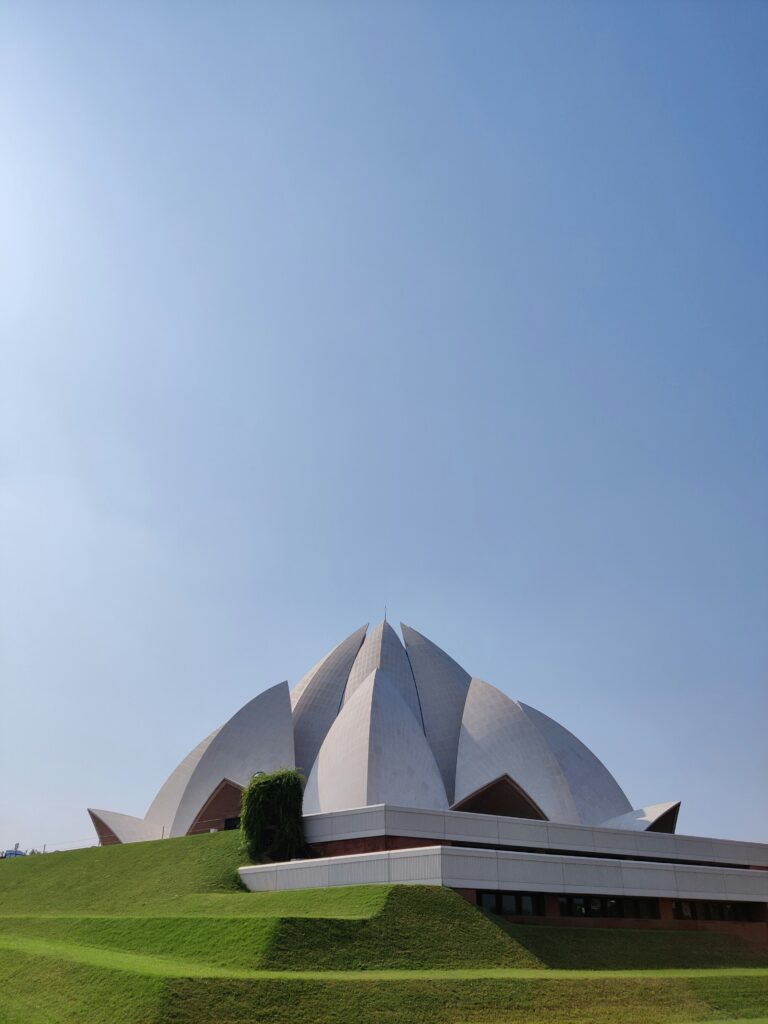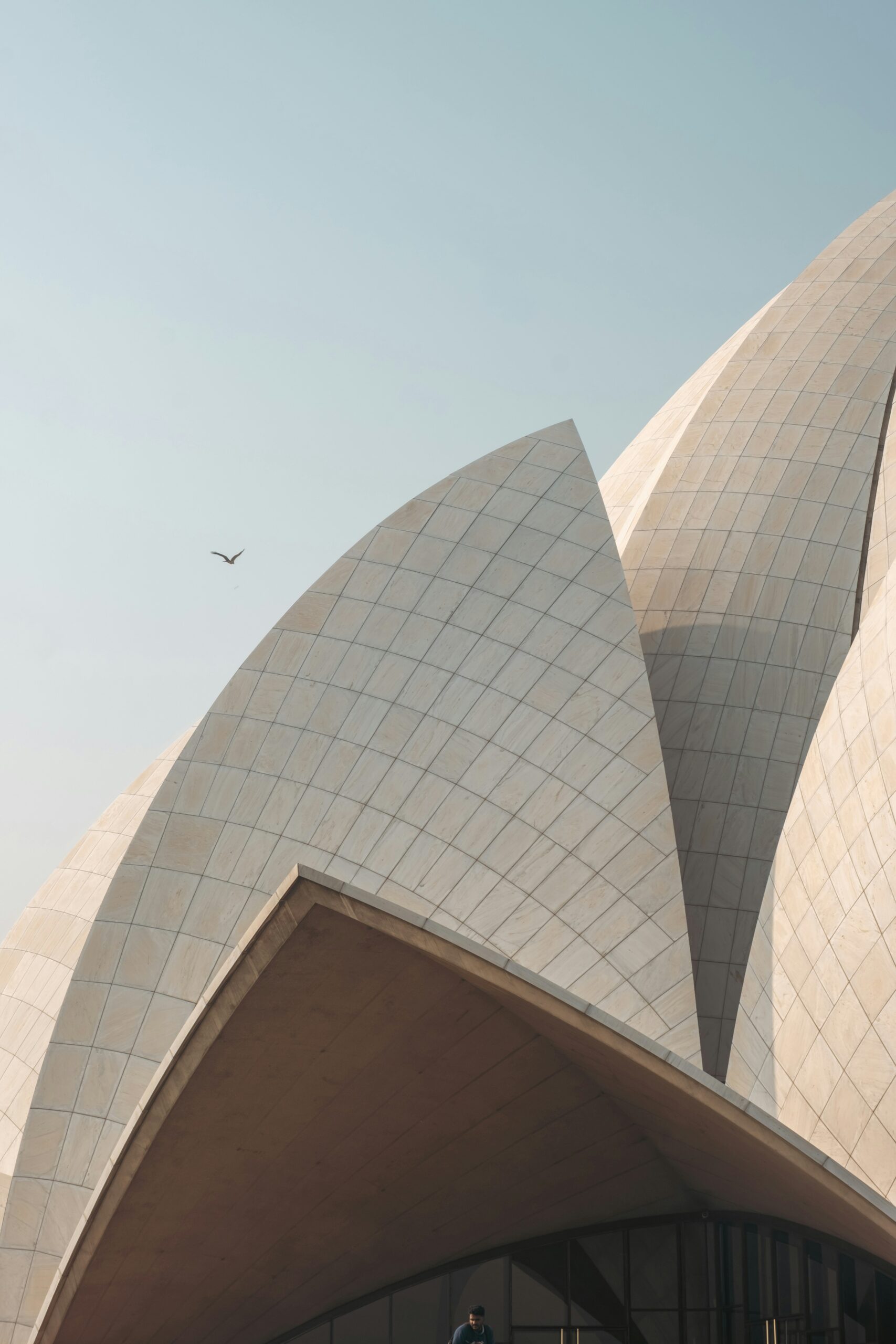Current Status & Recent Updates (2025)
The Lotus Temple underwent a major restoration project completed in 2024, addressing Delhi’s pollution impact on its pristine white marble exterior. The 27 Greek Pentelic marble petals received specialized cleaning and protective coatings to maintain their original brilliance.
Key 2025 Developments:
- Enhanced LED lighting system creates ethereal evening illumination
- Expanded solar power capacity now provides 25% of temple’s energy needs
- Improved visitor flow management during peak seasons
- New multilingual audio guides available in 12 languages
Recent visitor statistics show the temple now welcomes approximately 4.2 million people annually, with peak crowds during Delhi’s cooler months (October-March) and major holidays when daily visitors can exceed 100,000.
What Makes the Lotus Temple So Special?

The Lotus Temple’s revolutionary 27-petal design represents one of the most ambitious architectural achievements of the 20th century. Each “petal” is actually a sophisticated curved concrete shell clad in the same Greek Pentelic marble used for Athens’ Parthenon, creating an optical illusion that the structure floats weightlessly above its reflecting pools.
Unique Engineering Marvels:
- Computer-aided design pioneering: One of the first religious buildings designed entirely with computer modeling (1980s cutting-edge technology)
- Self-supporting petal system: No internal columns interrupt the prayer hall’s 1,300-person capacity
- Natural cooling system: Nine surrounding pools channel cooled air through hidden vents, keeping interiors comfortable even when Delhi temperatures exceed 45°C
- Seismic engineering: Structure designed to flex with earthquakes using innovative steel framework hidden within marble shells
Essential Lotus Temple Architecture Facts
Basic Specifications
- Height: 34.27 meters (112.5 feet) to apex
- Petals: 27 free-standing marble shells in three concentric rings
- Construction Period: 1980-1986 (6 years)
- Construction Cost: $10 million USD (1986)
- Architect: Fariborz Sahba (Iranian-Canadian)
- Structural Engineers: Flint & Neill (UK, now COWI)
Materials & Construction
- Primary Material: Greek Pentelic marble (same as Parthenon)
- Structural System: Reinforced concrete thin-shell design
- Cutting & Assembly: Marble cut in Italy, mounted with custom steel brackets
- Foundation: Raised podium with integrated water features
Capacity & Usage
- Prayer Hall Capacity: 1,300 seated visitors
- Daily Visitor Capacity: Up to 8,000 people
- Annual Visitors: 4+ million (2023-2024 data)
- Peak Day Record: 100,000+ visitors (religious holidays)
Lotus Temple History & Construction Timeline

1976: Vision Begins
Bahá’í community initiates planning for Indian subcontinent’s House of Worship, seeking design that honors local spiritual traditions
1980: Revolutionary Groundbreaking
Construction begins using pioneering computer-aided design and finite element analysis – cutting-edge technology for religious architecture
1982: Marble Sourcing Challenge
Architects source Greek Pentelic marble from same quarries as ancient Parthenon, requiring innovative curved-cutting techniques
1984: Engineering Breakthrough
Complex steel framework completed, enabling marble petals to appear structurally independent while maintaining seismic stability
1986: Sacred Opening
Temple consecrated December 24, 1986, immediately attracting international architectural recognition
1987-1989: Global Awards
Receives UK Institute of Structural Engineers Award (1987), Illuminating Engineering Society’s “Taj Mahal of 20th Century” citation (1988), and American Concrete Institute excellence award (1989)
2000: Century Recognition
Selected by Architectural Society of China as one of 100 canonical works of 20th-century architecture; receives GlobArt Academy’s “Taj Mahal of 20th Century” award
2014: UNESCO Consideration
Added to India’s tentative UNESCO World Heritage Sites list
2015: Solar Innovation
Becomes Delhi’s first temple with solar power installation (120 kW system)
2024: Major Restoration
Comprehensive marble cleaning and protective coating project completed
Why the Lotus Design? Cultural & Spiritual Significance

The lotus flower carries profound meaning across India’s religious traditions – Hinduism, Buddhism, and Jainism all revere the lotus as a symbol of purity, enlightenment, and spiritual emergence from worldly concerns. By adopting this universally recognized Indian spiritual symbol, architect Fariborz Sahba created a building that honors local culture while embodying Bahá’í principles of unity among all religions.
Sacred Symbolism:
- Nine-sided structure: Reflects Bahá’í sacred number representing completeness and unity
- Three petal rings: Outer petals open to sky, middle petals form entrance portals, inner petals create prayer dome
- Central skylight: Nine radial beams unite the inner petals while allowing natural light to filter into prayer hall
- Nine entrance doors: Welcome worshippers from all directions into unified space
Universal Spiritual Welcome: Unlike most religious buildings, the Lotus Temple explicitly welcomes people of all faiths. No sermons are preached; instead, visitors experience silent meditation and prayer. Devotional programs feature readings from various world scriptures – Bible, Quran, Bhagavad Gita, Buddhist sutras, and Bahá’í writings – emphasizing spiritual unity.
Things to Know Before You Visit the Lotus Temple
Best Times to Visit:
- Early morning (9:30-11 AM): Fewer crowds, optimal photography lighting
- Late afternoon (4-6 PM): Beautiful golden hour lighting on marble
- Weekdays: Significantly less crowded than weekends
- Winter months: Pleasant weather, blooming gardens
What to Expect Inside:
- Silence requirement: Respectful quiet maintained throughout visit
- Simple interior: No idols, altars, or religious imagery – only geometric marble beauty
- Seating arrangement: Simple benches accommodate 1,300 people
- Natural lighting: Sunlight filters through central skylight
- Prayer sessions: Brief devotional readings from various scriptures (no specific schedule)
Photography Guidelines:
- Gardens: Photography encouraged
- Exterior architecture: Unlimited photo opportunities
- Interior prayer hall: Photography prohibited
- Shoe storage: Secure areas provided at entrances
How the Lotus Temple Compares to Global Landmarks

| Feature | Lotus Temple | Taj Mahal | Sydney Opera House |
|---|---|---|---|
| Annual Visitors | 4.2 million | 6-7 million | 10+ million |
| Construction Time | 6 years (1980-86) | 22 years (1632-54) | 14 years (1959-73) |
| Material Innovation | Computer-designed marble shells | Hand-carved marble inlay | Prefabricated concrete shells |
| Religious Function | Active multi-faith worship | Memorial monument | Secular performing arts |
| Architectural Style | Modern expressionist | Mughal Islamic | Modernist sculptural |
| Engineering Innovation | Thin-shell concrete + CAD | Massive dome engineering | Interlocking shell geometry |
Visitor Experience Comparison: The Lotus Temple offers a uniquely contemplative experience compared to other architectural marvels. While the Taj Mahal impresses with historical grandeur and the Opera House dazzles with performance spectacle, the Lotus Temple provides spiritual tranquility – many visitors describe profound peace within its silent prayer hall.
Frequently Asked Questions About Lotus Temple Delhi
What is the Lotus Temple made of?
The Lotus Temple’s 27 “petals” are reinforced concrete shells clad in Greek Pentelic marble – the same high-quality white marble used for Athens’ Parthenon. This marble was cut to precise curves in Italy and mounted using specially designed steel brackets.
Is the Lotus Temple open on Mondays?
No, the Lotus Temple is closed every Monday for maintenance. It’s open Tuesday through Sunday with varying hours based on season (9 AM-7 PM summer, 9:30 AM-5:30 PM winter).
How many visitors does the Lotus Temple get daily?
The Lotus Temple averages 10,000-15,000 daily visitors, with capacity for up to 8,000 people at any given time. On major holidays, daily visitors can exceed 100,000 people.
Why can’t you talk inside the Lotus Temple?
Silence is maintained to create a universal worship environment where people of all faiths can pray or meditate comfortably. This policy reflects Bahá’í principles that spiritual connection transcends spoken words and religious boundaries.
Does the Lotus Temple charge admission fees?
No, the Lotus Temple is completely free to visit. Like all Bahá’í Houses of Worship worldwide, it welcomes visitors without charge as part of the faith’s commitment to universal accessibility.
How long does a Lotus Temple visit take?
Most visitors spend 45-90 minutes total: 15-20 minutes inside the prayer hall, 20-30 minutes exploring gardens and exterior, plus time for security screening and shoe removal/retrieval.
Travel Tips for Your Lotus Temple Visit
Getting There:
- Metro is best: Kalkaji Mandir Station (Violet Line) offers the most reliable transport
- Avoid rush hours: Delhi Metro gets extremely crowded 8-10 AM and 6-8 PM
- Parking availability: Free on-site parking, but fills quickly on weekends
What to Bring:
- Comfortable walking shoes: You’ll remove them before entering, so easy slip-ons work best
- Water bottle: Delhi heat can be intense, especially in summer
- Camera: For garden and exterior photography (not allowed inside)
- Light scarf: Useful for sun protection and respectful covering if desired
Nearby Attractions:
- Kalkaji Devi Temple: 10-minute walk, ancient Hindu temple
- Nehru Place: Major shopping district, 15 minutes by metro
- ISKCON Temple: Modern Krishna temple, 20 minutes by car
Conservation Challenges & Future Outlook
Like many white marble monuments worldwide, the Lotus Temple faces ongoing conservation challenges from Delhi’s air pollution. The pristine marble petals have gradually shown yellowing and graying similar to the Taj Mahal’s pollution damage in Agra.
Current Conservation Efforts:
- Annual marble cleaning: Specialized techniques preserve original whiteness
- Protective coatings: 2024 restoration applied advanced sealants
- Air quality monitoring: Temple tracks pollution impact on structure
- Preventive maintenance: Regular inspection and treatment of marble surfaces
Future Sustainability: The temple’s 2015 solar installation marked its commitment to environmental responsibility. Plans include expanding renewable energy capacity and implementing additional green technologies to reduce environmental impact while preserving this architectural marvel for future generations.
Explore More Modern Religious Architecture
Ready to discover more extraordinary spiritual spaces? Our architectural exploration continues with buildings that push the boundaries of faith, design, and human imagination.
Related Deep Dives:
- Ryugyong Hotel: North Korea’s Mysterious Pyramid Skyscraper – Another bold architectural experiment with spiritual undertones
- Modern Sacred Architecture: When Faith Meets Innovation – Global survey of revolutionary religious buildings
- Celebrity Homes with Temple-Inspired Design – How spiritual architecture influences luxury residential design
